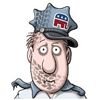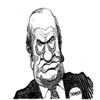Fixing the Presidential Debates
WASHINGTON -- The sloping red line offers a sobering prognosis for American democracy. Contained in a new report on improving the presidential debate process, it charts the precipitous decline of viewership: from above 60 percent of the voting age population in 1960, when the first televised debates were held, to under 30 percent in 2012.
In truth, 1960 was a particularly high-water mark: viewership hasn't cracked 50 percent since. It fell to as low as 23 percent in the 2000 race.
But the red line may also understate the problem. The largest segment of viewers watched only one of them. In 2012, their average viewing time was a scant 35 minutes.
Can this trend be changed? Can the content of debates be improved? Does the institution even matter? A new report from debate experts of both parties convened by the Annenberg Public Policy Center of the University of Pennsylvania assumes that the answer to the third question is yes, and offers suggestions -- some obvious, some provocative -- to address the first two.
First, though, it's worth dealing with the "do debates matter" issue. If matter means changing outcomes, the political science literature suggests that this is unlikely, despite all the effort that campaigns devote not only to debate prep but to negotiating arrangements down to the most picayune detail. Political conventions, for all their seeming obsolescence, have a bigger impact.
"There is no case where we can trace a substantial shift to the debates," writes University of North Carolina political scientist James Stimson. "But in elections that were close at debate times, there are cases (1960, 1980, 2000) where the debates might have been the final nudge."
I'd argue this is the wrong question. The general election debates may matter to campaigns because they can have an impact at the margins. They matter to democracy because -- at least in theory -- they help educate voters about the content of the candidates' positions, as well as the quality of their minds.
But debate organizers could do a better job at both, and in the process entice more voters to watch, which is where the Annenberg group comes in. Co-chaired by Obama campaign adviser Anita Dunn and Romney campaign adviser Beth Myers, the group makes some basic suggestions that would haul debates into the modern era.
Timing, for one: the rise of early voting argues for moving debates earlier. In 2012, nearly 7 percent of voters had cast their ballots before the third presidential debate, on Oct. 22.
Technology, for another: in a multiplatform, multicultural age, the debate feed should be readily available not only on traditional broadcast networks but on alternative venues, including Spanish language Univision and Telemundo and social media.
The tougher challenge involves dislodging the candidates from delivering canned set pieces and premeditated one-liners. That will never be fully achieved, but the existing format, of fixed-time answers and rebuttals and little candidate-to-candidate interchange, promotes this air of a minutely choreographed minuet.
Hence the most intriguing of the Annenberg recommendations, to transform the debate structure -- and, as an added benefit, reduce the role of the moderator and associated complaints about whether they are biased or interject either too much or too little.
One possibility would be a "chess clock" format under which candidates would be allotted 45 minutes of speaking time. "To take control of the floor, a candidate simply hits the chess clock," the report suggests. "No answer, rebuttal or question may exceed three minutes." Candidates would be able to challenge one another, directly.
In the commission's model, the time would be spread, evenly, across eight topics. Even better, if riskier, would be to let candidates decide on their own how to manage their time, devoting more to tax reform and less to terrorism if they want.
Another would be to change the standard format to give each candidate two 90-second "challenge flags" to deviate from the usual minute-long response, 30-second rebuttal. Exercising the challenge flag would let the candidate clarify a response or respond to an attack. It sounds hokey, but it could make for a more compelling, and more informative, debate.
Sure, in a world of multi-device distractions, the report's cover image -- mom in pearls, dad in tie, and pajama-clad kids huddled around the black-and-white TV -- is not apt to be re-enacted.
But the more Americans watch debates, and more of them, the better off we'll be. Which is what makes the debate about debates worth having.
========
Ruth Marcus' email address is ruthmarcus@washpost.com.
Copyright 2015 Washington Post Writers Group






